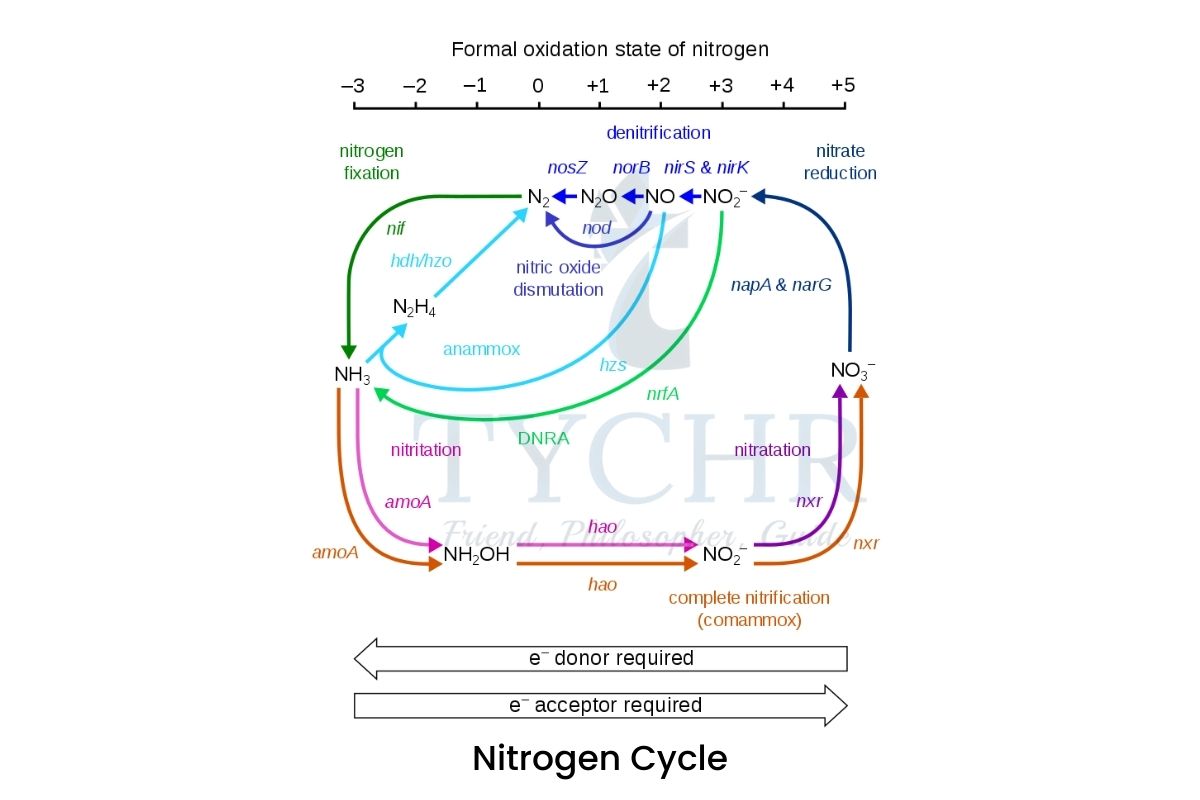ecology and conservation Notes
Ecology and conservation
Approaching the topic
- Understanding the key concepts
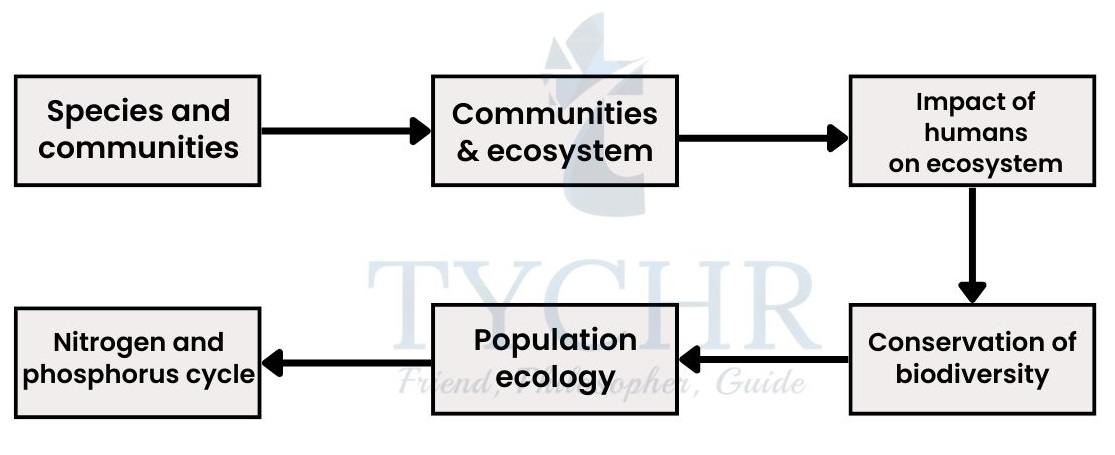
- Application of these concepts
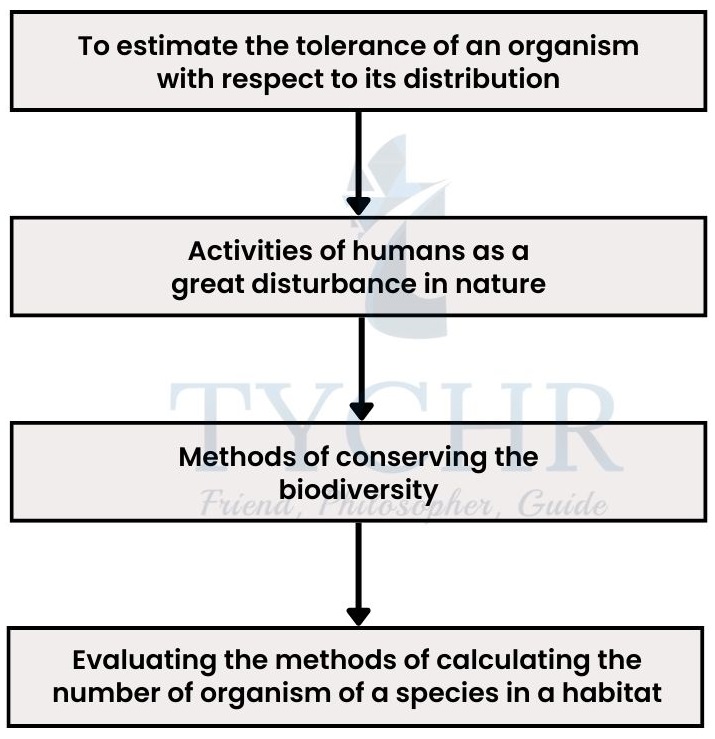
Species and communities
Introduction
- The group of organisms living in a habitat, comprising related features and are capable of interbreeding belongs is called species.
- When more than one species inhabit an area then it is called population.
- Group of populations living together and interacting with each other is called a community.
- The distribution of the species in a community depends on both biotic factors (other living organisms and there inter-relationships) and abiotic factors (temperature, light, water, soil and atmosphere) they are interacting
Limiting factors and distribution of species
- Abiotic and biotic factors sometimes act as limiting factors which results in distribution of the species according to their tolerance of limiting
- Shelford’s Law of tolerance: It states that, “the distribution of the species in an ecosystem is determined by the limits of physical and chemical factors that can be tolerated”.
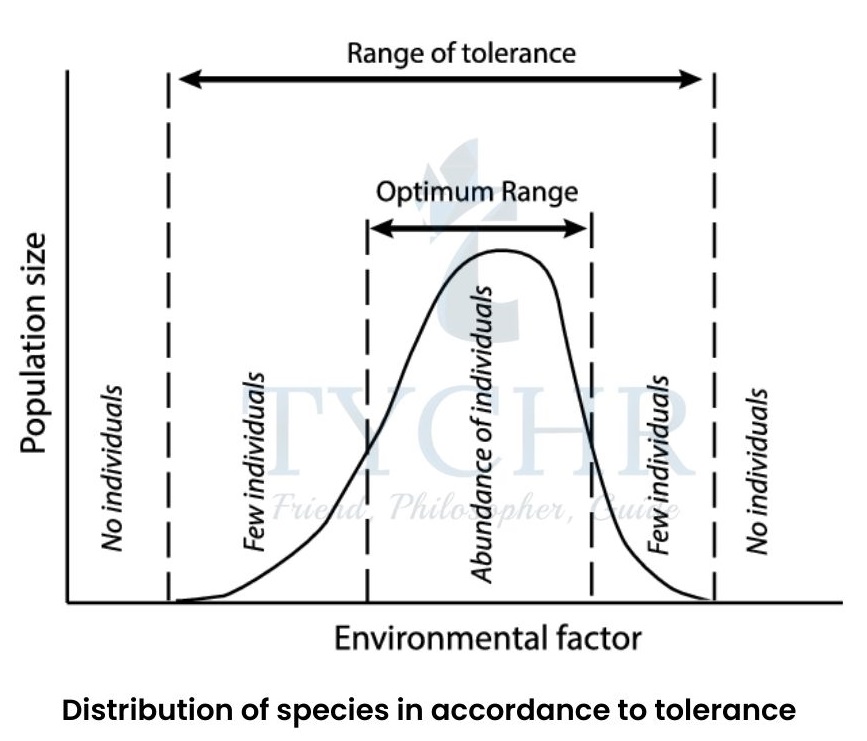
Figure 14.1 Distribution of species in accordance to tolerance - Examples include;
- Three species of kangaroos (Macropus rufus, Macropus giganteus, Macropus fuliginosus) live in three different habitats of Australia, due to their tolerance of limiting factors.
- A shrub plant of genus Encelia of California shows distributional patterns due to their tolerance.
Keystone species
- These are the species with high significance to maintain an ecological community. It takes strong control over a community by showing disproportionate effect. Removal of these species may harm the balance of the community.
- Robert Paine, first coined this term after experimenting in an intertidal area. He removed sea star, Pisaster ochraceous from the intertidal area and observed that a mussel, Mytilus californianus is taking over the algae and other invertebrates around.
- He then found that the sea star was keeping the mussel population under control. He collected the data that shows the declining number of species due to removal of sea stars.
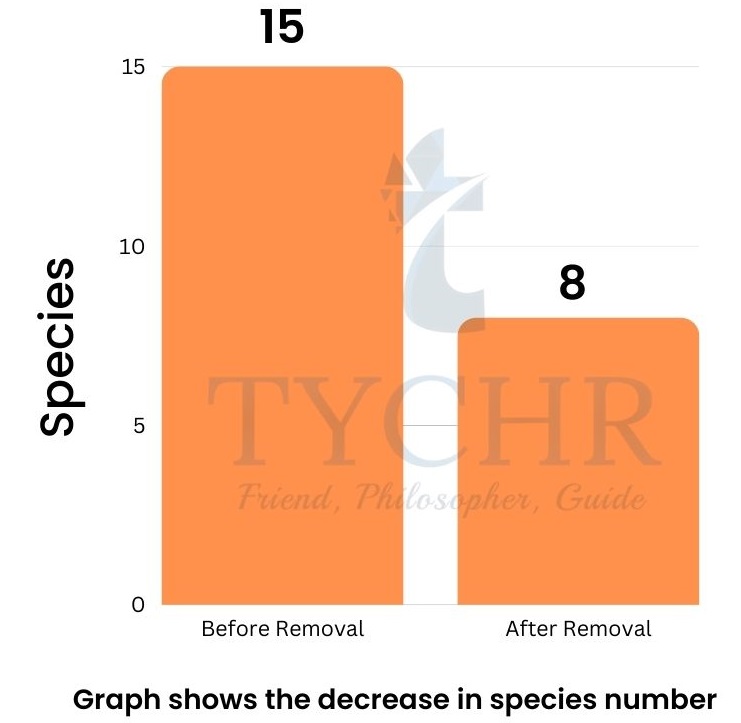
Figure 14.2 Graph shows the decrease in species number
Ecological niche
- All the parameters in which an organism lives, including its habitat, its feeding, its interaction with other organisms is called its niche.
Competition between species
- When two species in an area depend upon the same limited resource and if one of them gets a slight advantage, will be better
- The two species cannot coexist by inhabiting the same niche, one will out-compete the other at some time or they both will separate their niches to avoid overlapping of This is the competitive exclusion principle.
- Ecologist F. Gause demonstrated Competitive exclusion principle with two different species of Paramecium; P.aurelia and P.caudatum.
- He cultured these two species together with the constant food supply and observed that aurelia out-competed P.caudatum and survived.
- The difference in volume of both the species may be one of the reasons caudatum couldn’t thrive.
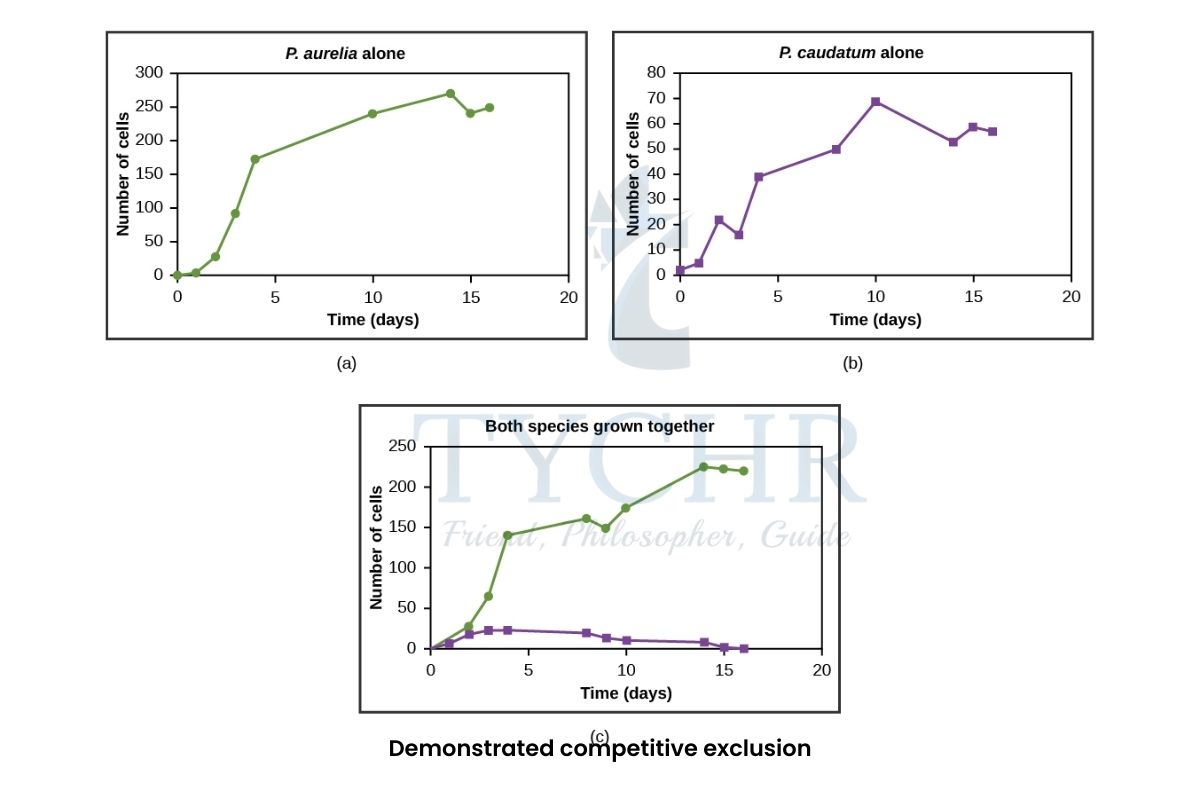
Figure 14.3 Demonstrated competitive exclusion
Interspecific interactions
- Herbivory: An interaction between plants and animals (belonging to the primary consumer level).
- Examples include;
- Rabbit eats marram grass in a sand dune ecosystem.
- Limpets feed on algae on rocks in intertidal zones on rocky shores.
- Predation: In predation, one is predator (secondary or above consumers) and another is prey (primary consumer) on which predator feeds. Prey population and predator population correlates with each other.
Examples include;- Blue heron preys on frog populations in ponds of the American sand dune ecosystem.
- Predator dingoes in New South Wales feed on prey red kangaroos.
- Leeches are parasites to mammals and humans as well, they secretes an enzyme to prevent clotting of blood so that they get unlimited supply to feed upon.
- Lungworm is a parasite to American bighorn sheep.Parasitism: In this interaction, one organism is host and the other is a parasite that lives in or on the body of the host. Parasite takes benefits from the host organism to complete their life cycle and harms them in return by affecting their cells or by sucking out nutrients.
- Malarial parasite, Plasmodium, causes malaria in humans. It enters the human body by the Anopheles mosquito stinging an individual.
- Lichen is a mutualistic relationship between algae and fungi. They co-exist, algae perform photosynthesis and make carbohydrates for fungi and fungi helps to absorb mineral ions from the soil that can be used by algae.
- Plant-animal mutualistic relationship is shown by fig tree being pollinated byMutualism: In this relationship, two species live in a close association and both of them benefit each other.
Examples include; wasps. Wasps lay eggs in the fig inflorescence and in turn fig gets pollinated. - Zooxanthellae (single-celled algae) and reef-building coral show symbiotic relationship. Coral provides a protected environment for algae by hiding it in their tissue and in return, algae make food by photosynthesis, accessible to coral to make calcium carbonate skeleton to make reef.
- Commensalism: In this interaction, one organism benefits from the other which is neither harmed nor benefitted in any way.
Examples include:- Orchid growing as an epiphyte on mango tree branches.
- Clown fish living among the tentacles of the sea anemone. Clown fish remain protected this way and do not need to go out in vulnerable environments to feed and instead, it takes the share of sea anemone.
- Hawkfish gets protection by hiding in the coral because it’s immune to the effects coral can do to it. Therefore, it is benefitted without helping or harming coral.
Transect
- It is a method of sampling a population of plants or animals along a longitudinal section of an ecosystem.
- Types:
- Line transects; a line is laid on the ground between two poles at distant. The number of organism touching the line will be recorded.
- Belt transects; two lines are laid at a distance of 5 m or 1 m.
- Point transects; a point is made and observation starts just within a certain radius from that point.
Communities and ecosystem
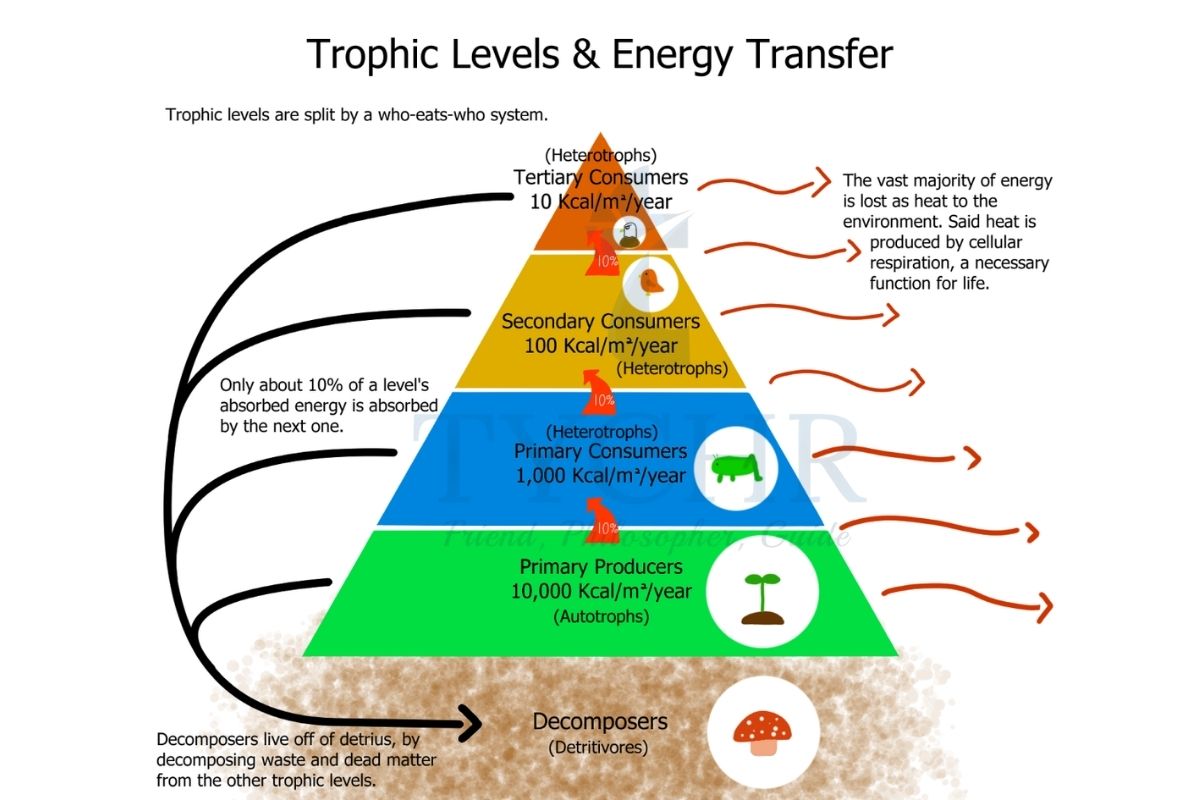
- Plants trap 1-2% of total sun energy out of which 80-95% gets lost as heat and in the maintenance (like tissue repair, growth, reproduction) of the plant itself.
- 5-20% percent of energy gets transferred to next trophic level i.e. primary consumer. Such like that, near about 10% of the received energy gets transferred to the successive trophic level (among consumers) and the rest is lost as heat.
- In animal husbandry, the energy transfer value is often >10%.
- Second law of thermodynamics stands true in this case as It states that, a portion of energy gets lost every time it gets transferred.
- The loss of energy in the food chain considers the transfer of energy to detritus, if the organisms die and the undigested mater.
Pyramid of energy
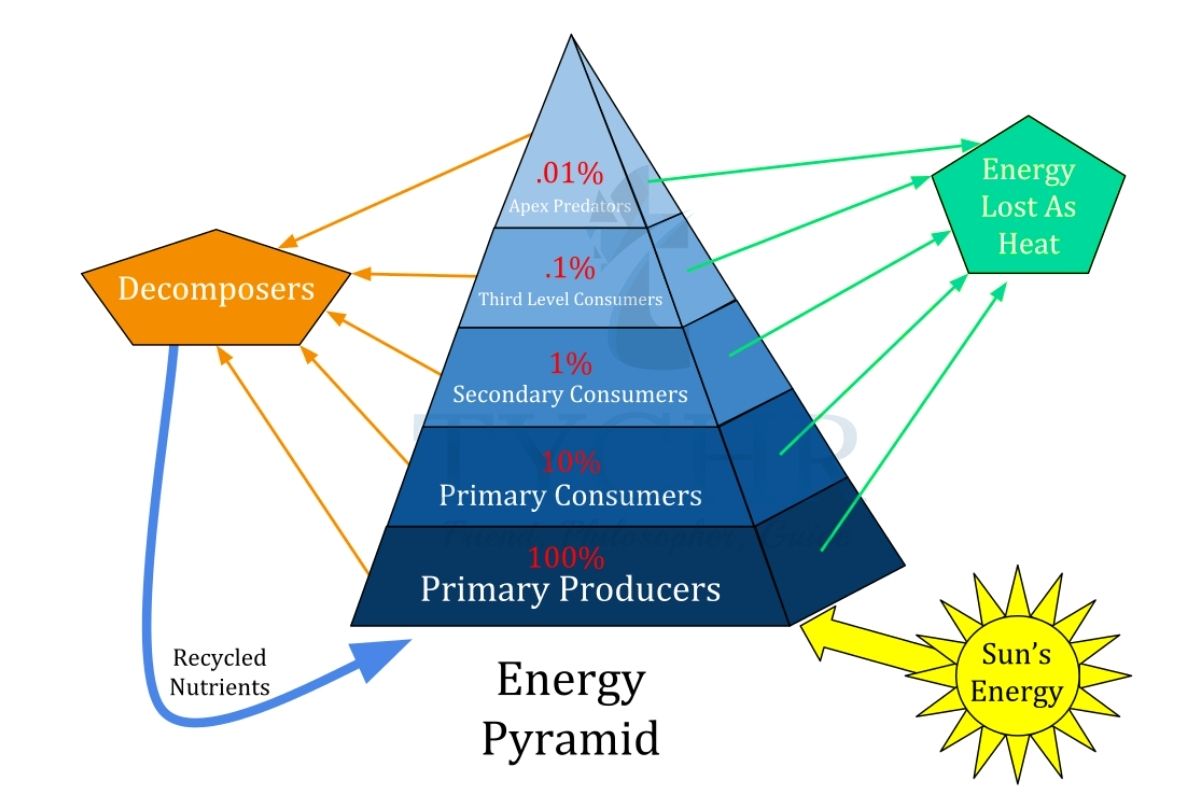
- It shows the available energy at each trophic level. As the most of the energy gets lost at each trophic level therefore it gets narrower as we go from producers to the tertiary consumer, giving it a shape of a pyramid.
- This available energy at each level is called net production e. it is the total energy (gross production) minus the heat loss energy. It is measured in kilojoules per metre squared per year (kJ m-2yr-1)
- Net productivity depends upon the length of the food chain. As the length of the food chain increases, the net productivity will increase.
Pyramid of biomass
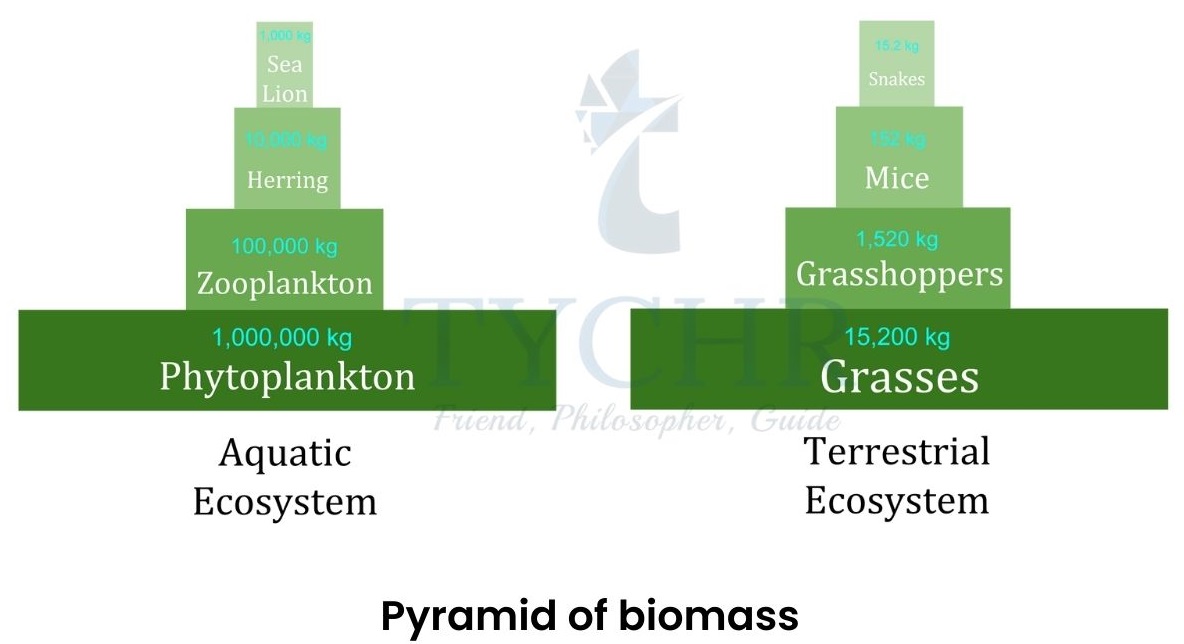
- Biomass is the calculation of dry weight present at each trophic level. It is measured in grams per metre squared per year (gm-2yr-1).
- It also gets lost at every trophic level because during cell respiration, glucose is broken down into CO2 and water, which gets excreted out of the body.
Feed conversion ratio (FCR)
- It is the measure of the quantity of mass gained in the body with respect to food ingested.
FCR = mass of food ingested/gain in body mass - The lower the FCR, the higher the efficiency of the organism. FCR = 1 would mean 100% conversion of the ingested food into the mass gained.
- FCR value of 1-2 can be found in fishes.
Ecological succession
It is the change in the abiotic and biotic factors in an ecosystem over time. The process of inhabiting living organisms with their abiotic factors in an area is called succession.
Two types of succession takes place depending upon the area; Primary succession and secondary succession.
- Primary succession:
- It is the type of succession that occurs on the land, where no life ever existed or not existing from past thousands of years.
- It starts with the invading of the bare area by pioneer species; lichens. They secrete some acids which can decompose the rock gradually into the soil.
- The soil then gets occupied by bryophytes (mosses) which hold the soil and prevent soil erosion.
- Eventually, these mosses get replaced by herbs and shrubs and later on the higher plants to obtain the stable climax community.
- It might take hundreds to thousands of years to reach a climax community from a barren land.
- Secondary succession:
- It occurs on the land that is already having a fertile soil and may have some roots or seeds also i.e. the land which may be abandoned, burned or flooded.
- The type of new species that invade the land depends upon the type of soil present.
- It is a much faster process than primary succession because the foundation to achieve climax community is already present. The species diversity is also greater.
- Climax communities will have more biomass than and hence higher net primary productivity.
Gersmehl diagrams
- These are the representational diagrams that demonstrate inter-relationship between the nutrient stores in an ecosystem. The nutrient stores are soil, biomass and litter.
- These three stores are also called storage compartments, which are represented by circles. The larger the circle, the more storage available.
- The flow of nutrients is represented by arrows. Thicker the arrow, more rapid would be the flow of nutrients.
- The diagrams are made for three main types of ecosystem named; tropical rainforest, taiga and desert.
- Making of Gersmehl diagram is according to the measurements certain of factors. These factors are weathering, leaching, precipitation, water runoff, biomass, soil nutrients and litter.
- Different ecosystems have different measurements.
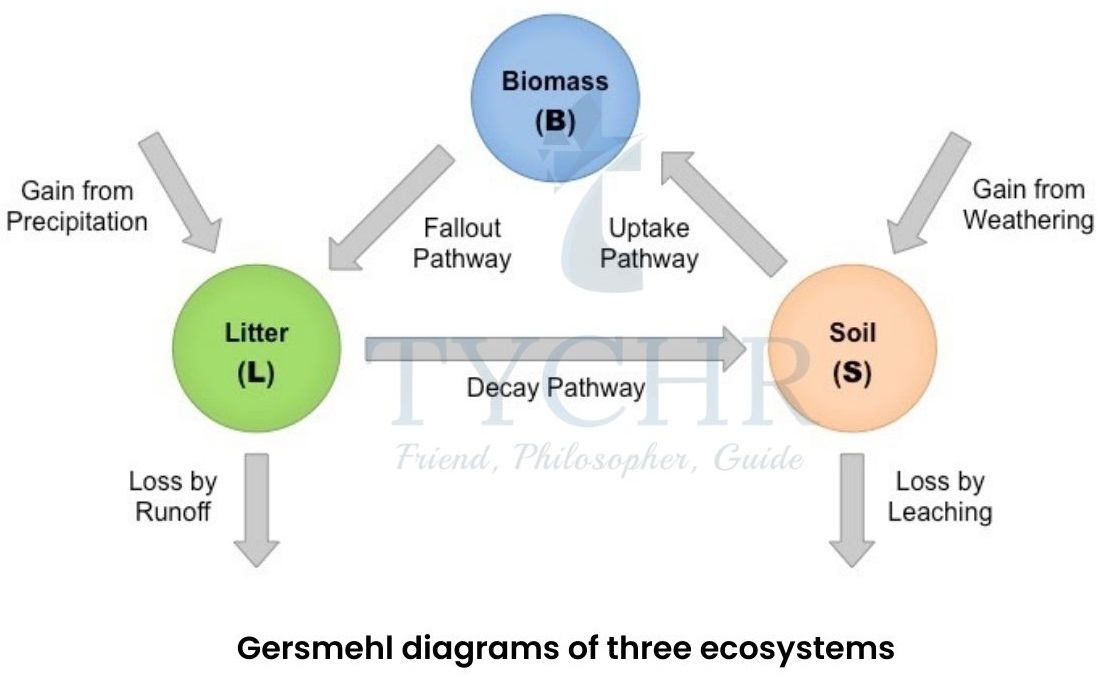
Figure 14.7 Gersmehl diagrams of three ecosystems
Biomes
Biome is the division of the biosphere which has well developed vegetation and extensive community. Global weather patterns and topography is the reason for their creations.
The distribution of these biomes is according to the rainfall and temperature.
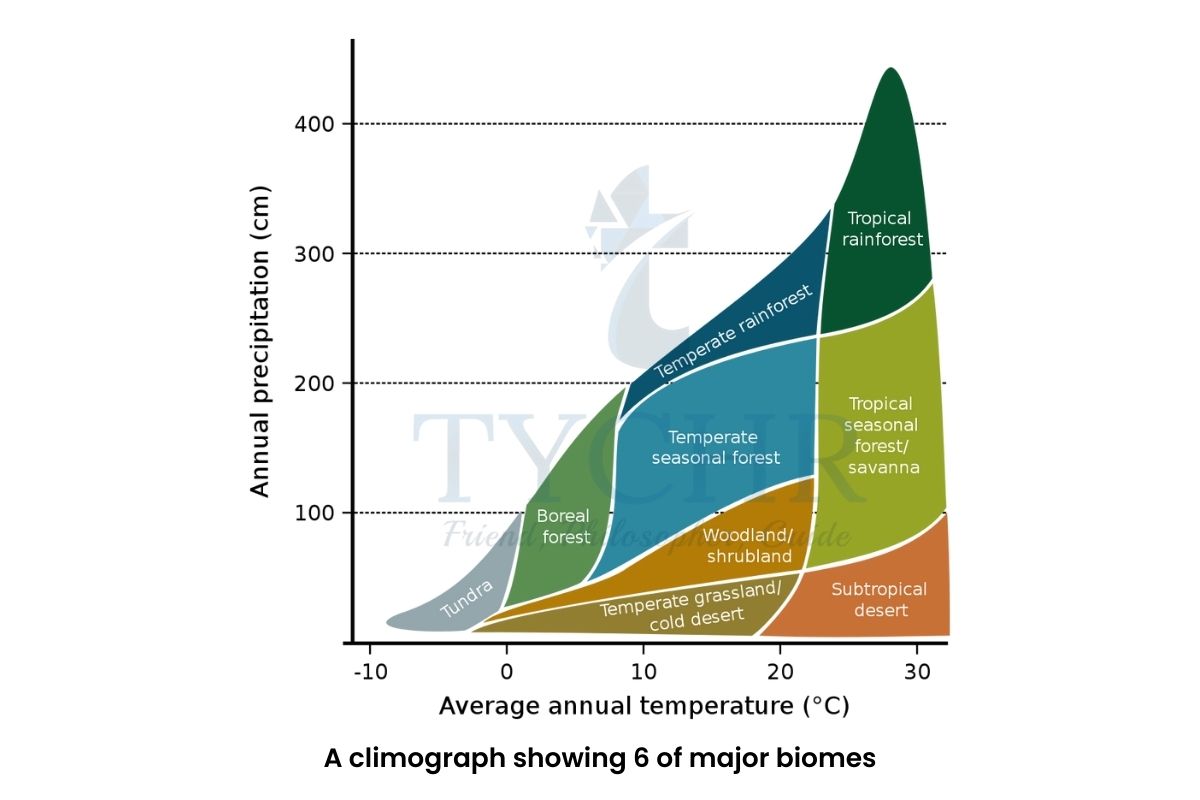
Biome | Temperature | Moisture |
Tundra | Very cold | Little precipitation |
Coniferous forest | Warmer than tundra but still cold | Little precipitation |
Grassland | Cold in winters and hot in summers | Moderate rainfall |
Temperate deciduous forest | Hot in summers and cold in winters | High rainfall |
Tropical rainforest | Very warm | High precipitation of >250 cm yr-1 |
Desert | Very hot with temperature >60ᵒC | Low precipitation of <30 cm yr-1 |
Closed ecosystem
- In a closed ecosystem, energy can be exchanged but not the matter. The entire earth planet is a closed system or it can be made artificially.
- Natural ecosystems are considered as open ecosystem because there is exchange of both the energy and matter.
Impacts of humans on ecosystem
Alien and invasive species
- Any introduced species by humans in an area of endemic species (native species) is called alien species.
- The alien species are introduced mostly as a measure of biological control, in which a predator species is introduced in an area or habitat to keep the specific prey population under control.
- This biological control goes wrong when the predator species find other abundant resources as food than the specific prey only and become invasive.
- Alien species become invasive, because they have resources, they reproduce and multiply, increasing the risk of extinction of many species and they have no predator of their own.
- Example;
Cane toads (one of the highly poisonous species of toads) were introduced in an area of Queensland, Australia to control the beetles that were harming the cane by eating their roots. Instead, cane toads find other resources there to tackle their needs and the beetle problem remains as it is. Also, cane toads were toxic to crocodiles and snakes, so they had no predators. This advantage led them to become more of a pest in Australia than beetles. - The invasion of alien species can out-compete endemic species (competitive exclusion principle). Like in the case of cane toads, they posed a great risk on the existence of blue-tongued lizard population.
- Another example of invasion of alien species was shown in UK; Introduction of the Eastern grey squirrel causes threat on the existence of native red squirrel.
Biomagnification
- It is the process of accumulation of chemical substances in higher trophic levels.
- The chemical substances become more concentrated at each higher trophic levels.
From where its starts?!- Fertilizers and chemical pesticides are sprayed on crops to prevent it from the attack of small insects and pests.
- These chemicals are taken up by the plants (but slight) and also get inside the soil and when it rains, they drown off into lakes and rivers.

Figure 14.9 Showing biomagnification of DDT - Example; DDT (dichlorodiphenyltrichloroethane). It is widely used pesticide in the world (now banned in USA and many other countries).
- DDT gets drowned off into the rivers and contaminates the water.
- It enters the zooplankton and then small fishes, large fishes and even more large fishes.
- Then it gets transferred to fish-eating birds. The concentration increases at successive trophic levels.
- Consequences:
The birds eating fish (having DDT) accumulate much of DDT in them as well. This interferes with the formation of calcium carbonate layers of their eggs. The layer form is so thin that it can break very easily, even with the weight of the mother sitting on them. This ultimately leads to declination in the predatory bird population.
Boons and banes of DDT DDT was used as insecticide to control ticks and mosquitos during World War II. DDT spraying could prevent large populations from malaria and also protects crops from small insects and pests. Therefore it was being used widely for human use in 20th Century, until its harmful effects were found later in 20th Century. DDT accumulates in fat tissue in humans including breasts in females. Therefore it can have many adverse effects on human health including infertility, cancer, brain diseases etc. Fortunately, its manufacturing is discontinued in most of the known countries except India. |
Plastic in the marine environment
Two kinds of plastics found in the ocean that are considered extremely harmful for marine populations; Microscopic plastic and macroscopic plastic.
- Microscopic plastic:
- Plastic particles smaller than 5 mm are called microscopic plastics.
- In the oceans, they soak up toxic chemicals found in the water like a sponge, which is an advantage because water gets cleaned. But, it can be a threat to the living organisms associated with the ocean like fishes, crabs, turtles and birds.
- The life of the ocean consumes this plastic, mistaking it for food. The plastic with toxic chemicals causes extreme damages in the bodies of aquatic organisms.
- It is also ingested by lugworms found near or in the oceans. The chemicals interfere with their system and make them weak, more vulnerable to their predators because they can’t churn to bottom sediments to protect themselves.
- Macroscopic plastic:
- Plastic pieces bigger than 5 mm are considered as macroscopic plastics.
- It includes plastic bottles, bags, and nets etc. which are ingested by marine life mistakenly as food.
- Ingestion of macroscopic plastics also causes the same problems like microscopic plastic do, but it is a major concern.
Phoebastria immutabilis Laysan albatross is one of the sea birds found in southern hemisphere and in North pacific region. This species of birds is famous for ingesting a lot of plastic (thinking of it as food) during its lifespan. They feed their chicks plastics objects which causes blockage in their digestive system and real soon, the death. It has same harmful effects on the adult albatross which results in their death too. |
Conservation of biodiversity
Biodiversity – It is defined as the degree of variation of life forms in an ecosystem. It can be described by its two components; richness (number of different species present) and evenness (the closeness or relatedness of the species with each other).
Indicator species
- These species are sensitive to the environment and therefore used to assess the specific environmental
- They act as an indicator of the environmental condition by their absence or presence on a specific
- Examples include:
- Lichens; they are sensitive to pollution in the atmosphere, therefore will only be present in less polluted area.
- Macroinvertebrates; are used as to judge the quality of the water they live in (during aquatic stage of their life cycle). Some of the invertebrates are highly sensitive like mayfly larva, planarian, stonefly fly larva etc. while some are tolerant like lunged snail, leeches, aquatic worm etc.
So the water will be cleaner where sensitive invertebrates are present because they must have more oxygen and less organic matter in water around them.
Biotic index
- It tells the relative frequency of the indicator species with respect to its surroundings.
- Calculation steps:
Determine the number of individuals of each indicator species (very sensitive, moderately sensitive and tolerant species) collected in a sample. - Multiply each of the number of species with pollution tolerance factor and add them. The total is divided by the total number of organisms found.
- Calculation steps:
Types of biodiversity conservation
There are two methods of conservation; In situ conservation and ex situ conservation.
- In situ conservation
- This is the method in which endangered species are kept in their well-adapted habitat without the interference of any invasive species.
- These natural reserves are specially designated for conservation of wildlife and can be terrestrial and aquatic as well.
- Management of these natural reserves is done by humans in a manner which involves:
- Maintaining the extra vegetation like shrubs and trees under control.
- Protecting the target species from the invasive species.
- Re-introduction of the species, if become extinct from that particular natural reserve.
- Prevent poaching.
- Ex situ conservation
- In this method, the species are kept in personalised care apart from its natural habitat, due to its high risk of extinction.
- It is the last resort of conserving any species after in situ conservation. And three following methods are used to conduct:
- Captive breeding –It follows certain techniques like artificial insemination, cryogenics (Storing male or female gametes or embryos by freezing), etc. This method is helpful in saving endangered animal species. They are reintroduced if they go extinct in the wild.
Examples include; Mexican grey wolf was saved from extinction in western USA. - Botanical gardens – Examples include; Mexican grey wolf was saved from extinction in western USA.
- Seed banks – Seed are remains conserved in seed banks under very low temperature and dark conditions. These conditions keep the seed viable for many years.
- Captive breeding –It follows certain techniques like artificial insemination, cryogenics (Storing male or female gametes or embryos by freezing), etc. This method is helpful in saving endangered animal species. They are reintroduced if they go extinct in the wild.
Biogeographical effects on species diversity
There are three biogeographical factors which influence the diversity:
- Latitude gradient:
Climatic conditions change when we go away from the equator, which are considered as non-favourable for living species. Therefore species diversity decreases in going away from the equator. - Elevation gradient (altitude):
Species richness increases while going up but up to the midpoint bulge, after that it starts decreasing. - Area effect:
The larger the area, the more species that will be accommodated and hence greater species richness and vice versa with the smaller area.
Edge effect
It is shown when two borderline ecosystems overlap each other and therefore influence each other. It describes the effect of the two ecosystem influences on species diversity.
It is proved that the interior habitat and edge of a habitat together promotes species richness in an ecosystem.
Population ecology
- Population dynamics
- Population of a certain area depends on the four factors:
- Natality; number of new individuals born and added to the population in a year.
- Mortality; the number of deaths in a year.
- Immigration; number of individual arrived from other places and stayed in a year.
- Emigration; number of individual left the population in a year.
- Population of a certain area depends on the four factors:
Population growth curve
- When a habitat has limited supply of resources then S-shaped (sigmoid) curve graph in shown by the It is also called logistic growth curve.
- It is described in three stages:
- Exponential growth phase: The resources are unlimited and there is no or very little competition in starting, therefore the population grows at much higher rate. Natality is high.
- Transition phase: Increase in completion due to increasing population, predator’s attraction and spread of diseases (if any) are the causes that the population growth slows Natality low down while mortality increases.
- Plateau phase: Resources limit due to their excessive use, predators attack increases due to high prey population are the causes of no further growth of population. In this phase natality is equal to mortality.
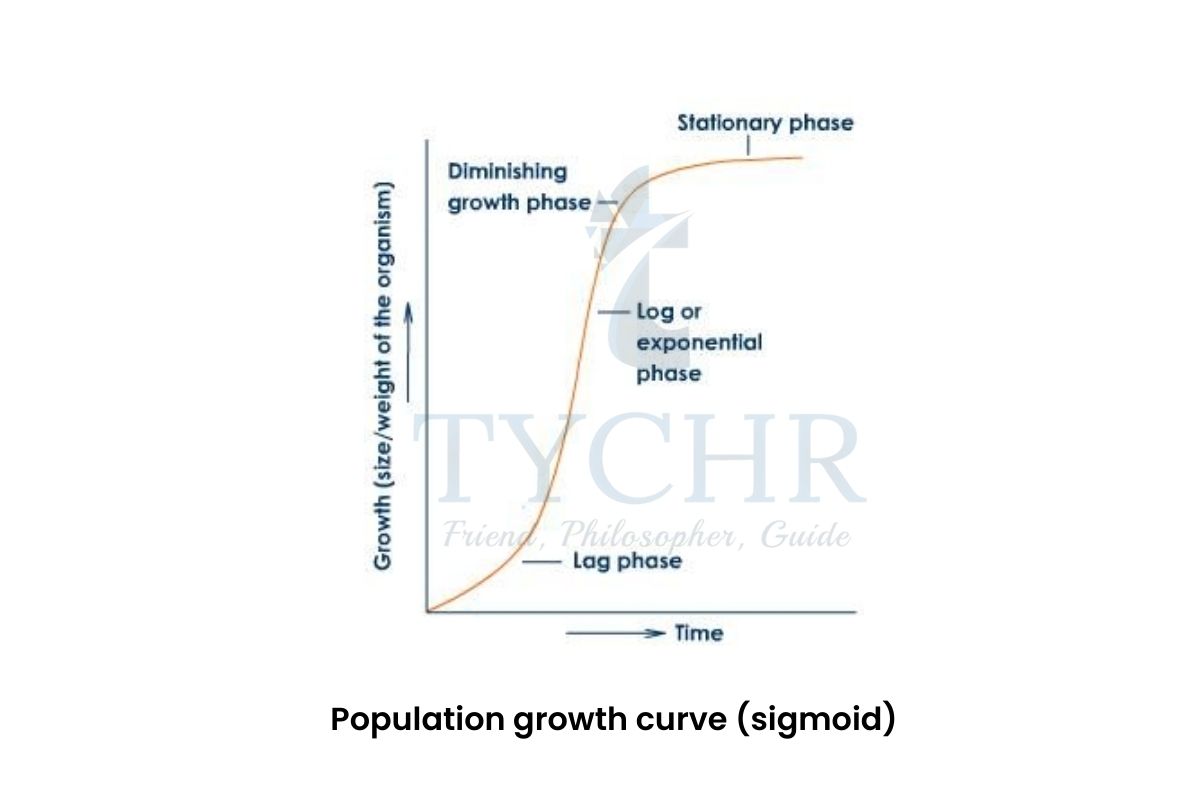
Figure 14.10 Population growth curve (sigmoid)
- Carrying capacity (K):
It is the maximum number of individuals supported by a habitat. The plateau phase in growth curve defines it (when maximum carrying capacity is reached).
It is influenced by two limiting factors of nature:- Bottom-up limiting factor; is the factor when resources such as nutrients, space and food influence population.
- Top-up limiting factor; is when predators interfere in a population.
Animal population estimation method
- To estimate an animal population in an ecosystem, capture-mark-release-recapture method is used.
- In this method, a sample of the animal population is captured and marked by a marker and is released back. Then, a second sample population is taken after a while and obviously some in the population will be marked and some will not.
- It can be observed that,
number of marked in the 2nd sample (𝑛3)/total number caught in the 2nd sample (𝑛2) = number marked in the 1st sample (𝑛1)/size of whole populaion (N)
i.e. 𝑁 = (𝑛1 × 𝑛2 )/𝑛3
Nitrogen and phosphorus cycle
Nitrogen cycle
- It is mainly regulated by certain bacteria in the following ways;
- Nitrogen fixing bacteria fixes atmospheric nitrogen.
Ex – Rhizobium (symbiotic) and Azotobacter (free living). - Another type of bacteria performs nitrification in which ammonia is converted into nitrites. Ex – Nitrosomonas.
- The bacteria named Nitrobacter then convert nitrites into more useable forms nitrates.
- The nitrates then travel into the roots of the plants by expenditure of energy (ATP). These are used to make proteins in the plants called assimilation.
- When plants or animals die, all the nitrogen matter from their body is broken down by decomposers and free nitrogen gets back into the environment. This activity is called putrefaction.
- Denitrifying bacteria such as Pseudomonas denitrificans reduce nitrate and nitrite back into the nitrogen gas to be released into the environment.
- Nitrogen fixing bacteria fixes atmospheric nitrogen.
Eutrophication The accumulated amounts of nitrogen and phosphorus in the lakes, ponds or rivers due to run off excess nitrate fertilizer from farms and from industrial or commercial discharge in the streams. |
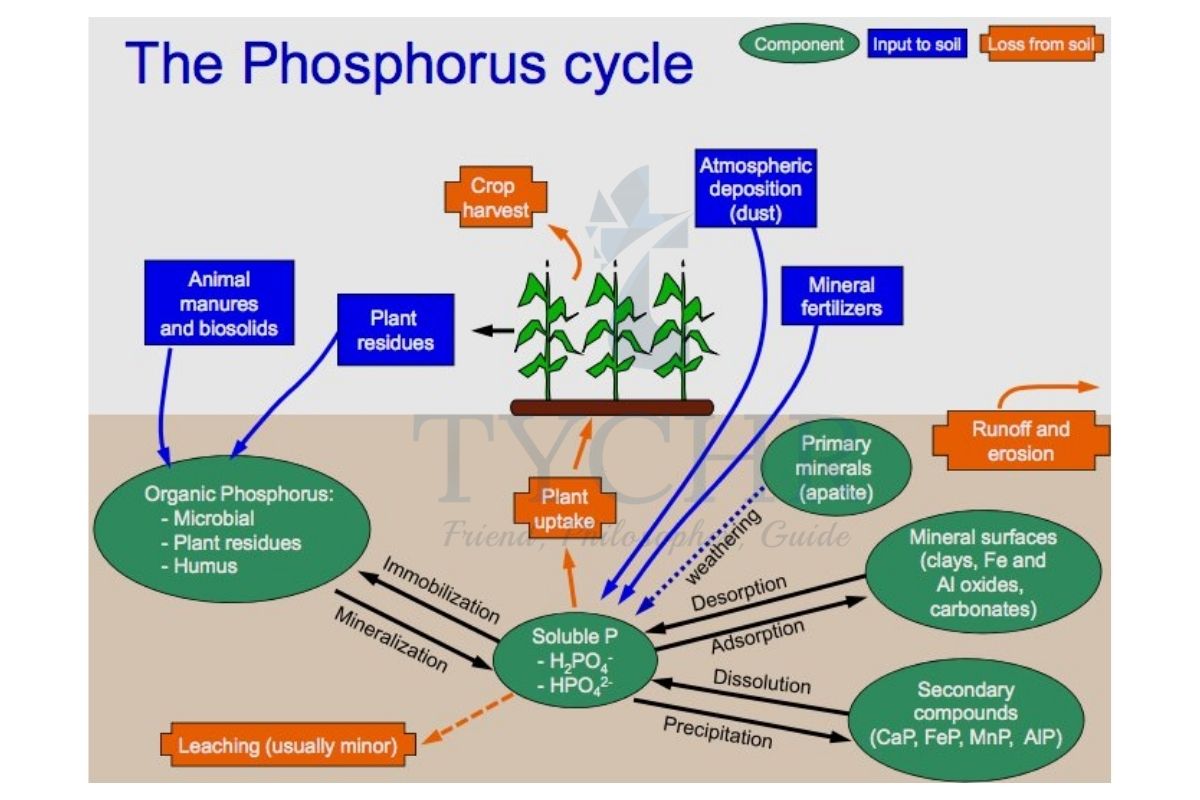
Phosphorus cycle
- Phosphorus is found in marine sediments and mineral deposits and is a main component of DNA, RNA and ATP.
- Slow weathering of sedimentary rocks releases phosphorus into the soil from where it is taken by plants and hence, its turnover is low.
- When the crops are harvested, the phosphorus in the soil is removed or drained off into the water bodies. Therefore, there is a need to add phosphate as in chemical fertiliser to the soil every time.
- This activity is reducing the phosphorus reserves rapidly and may be one of the limiting factors in agriculture in the future.

